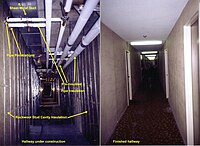
Photo from wikipedia
Abstract Historical structures are generally vulnerable to damages under earthquakes over the course of their life and are subject to be retrofitted to preserve the heritage against any possible extreme… Click to show full abstract
Abstract Historical structures are generally vulnerable to damages under earthquakes over the course of their life and are subject to be retrofitted to preserve the heritage against any possible extreme loads, particularly earthquakes. This process is handled via analysis by taking into account existing condition of the buildings, however, there are few studies focusing on the effectiveness of the applied retrofitting solutions. Therefore, there is a growing need to understand and compare the earthquake behavior of historical structures before and after retrofitting states. This paper aims at investigating the structural behavior of a historical timber/masonry building for conditions both before and after the retrofitting of the building. To enable a comparison for conditions, firstly theoretical finite element models were developed and then experimental operational modal analyses of the historical building were performed. Secondly, the experimental data regarding the dynamic response of the structure was obtained by ambient vibration tests and finite element models were updated. Two final updated models representing before and after the retrofitting states were developed. The final models selections were based on the convergence between the experimental and analytical natural frequencies, and the mode shapes. The updated final models enable to assess the earthquake behavior of the structure for both before and after retrofitting states. Furthermore, updated finite element models of the building for both before and after the retrofitting states were analyzed by a recorded earthquake in Turkey. Dynamic responses of the structure including principal stresses and displacements before and after retrofitting were compared and the impact of retrofitting is evaluated. The results show that the stiffness of the retrofitted structure has increased 3 times compared to its initial condition. The finding of this study will be beneficial to develop FEM models for a wide range of possible future retrofitting solutions.
Journal Title: Construction and Building Materials
Year Published: 2018
Link to full text (if available)
Share on Social Media: Sign Up to like & get
recommendations!